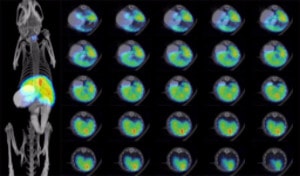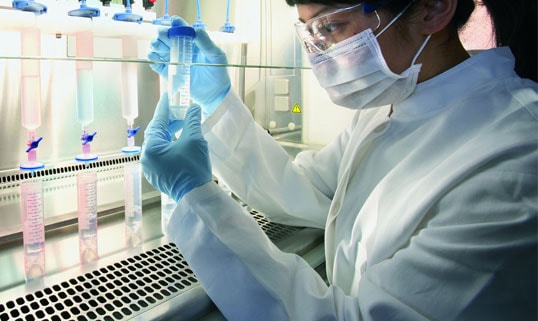Hepa1-6-Fluc-Neo/eGFP-Puro
- Frozen / Standard (CL133-STAN) $ 2,100
Species: Mouse
Cell type: C57/L hepatoma
Transgenes: Firefly luciferase (Fluc) with neomycin resistance (Neo) for selection with G418 and enhanced green fluorescent protein (eGFP) with puromycin resistance (Puro) for selection with puromycin
Media: DMEM, 10% FBS, 1% Pen/Strep, 1.25 mg/mL G418, 2 μg/mL puromycin
Description: Hepa1-6-Fluc-Neo/eGFP-Puro is a polyclonal population derived from the hepatoma Hepa1-6 cell line (ATCC® CRL-1830TM) transduced with 1) LV-Fluc-Neo (LV011) encoding the firefly luciferase (Fluc) cDNA under the spleen focus-forming virus (SFFV) promoter linked to the neomycin resistance gene via a P2A sequence, and 2) LV-eGFP-PGK-Puro (LV031) encoding the enhanced green fluorescent protein (eGFP) cDNA under the spleen focus-forming virus (SFFV) promoter and the puromycin resistance gene under control of the PGK promoter.
The lentiviral vectors used are self-inactivating (SIN) vectors in which the viral enhancer and promoter has been deleted. Transcription inactivation of the LTR in the SIN provirus increases biosafety by preventing mobilization by replication competent viruses and enables regulated expression of the genes from the internal promoters without cis-acting effects of the LTR (Miyoshi et al., J Virol. 1998).
Mycoplasma Testing: The Hepa1-6-Fluc-Neo/eGFP-Puro cell line has been tested for mycoplasma contamination and is certified mycoplasma free.
Cell Line Authentication: The parental Hepa1-6 cell line was authenticated and cells are certified free of interspecies cross-contamination by short tandem repeat (STR) profiling with 27 STR loci.
Recommended uses:
In vitro: This is a high luciferase and GFP expressing cell line suitable for use as a positive control cell line in bioluminescence and fluorescence assays to verify luciferase or GFP expression respectively in your lentiviral transduced cells.
In vivo: Hepa1-6 cells form primary tumors and spontaneous lung metastases post implantation into syngenic C57L/J mice. The Fluc transgene facilitates in vivo noninvasive bioluminescent imaging of implanted cells. Fluc and eGFP are immunogenic and may cause tumor rejection in immunocompetent mice. For the most consistent results, immunocompromised mice are recommended for studies. Due to high background autofluorescence in animals, eGFP is not recommended for whole animal in-live imaging. Rather, samples can be collected post mortem for analysis by conventional fluorescence microscopy.
Publications using associated reagents:
LV-eGFP-PGK-Puro (LV031): Shen et al. Immunovirotherapy with vesicular stomatitis virus and PD-L1 blockade enhances therapeutic outcome in murine acute myeloid leukemia. Blood. 2016. March 17: 127(11): 1449-58.
Cell Morphology: Low- and high-density cell morphology (200x)

Luciferase Assay: 104, 105, or 106 cells were placed in wells of a 96-well plate and 0.3 mg of d-luciferin was added. The plate was immediately imaged using a Xenogen IVIS Spectrum.

Flow Cytometry for eGFP: Hepa1-6-Fluc-Neo/eGFP-Puro (green) or control (Hepa1-6; grey) cells were fixed with paraformaldehyde and analyzed by flow cytometry.


